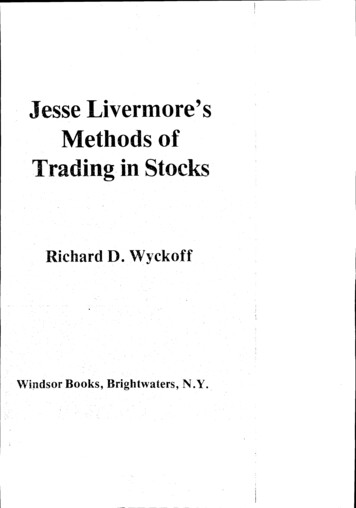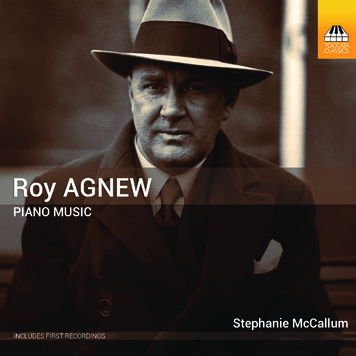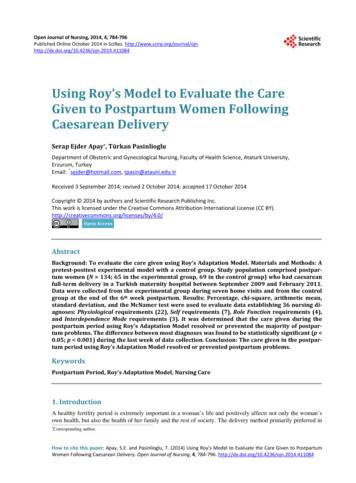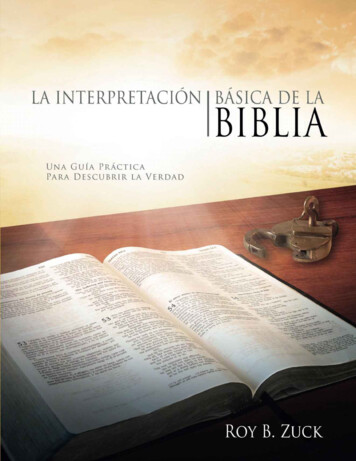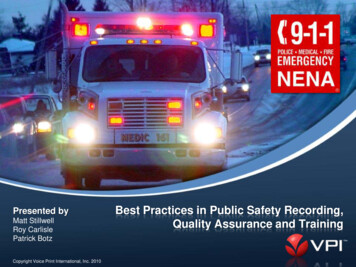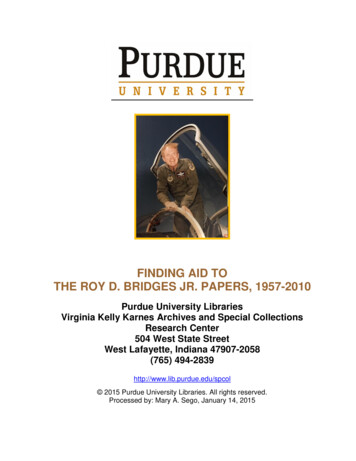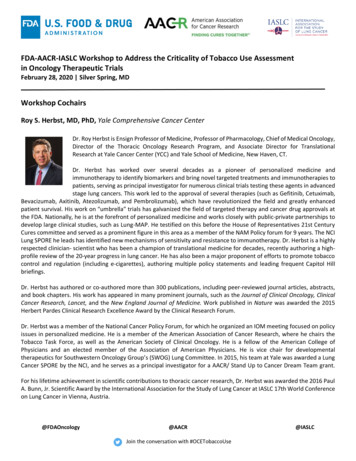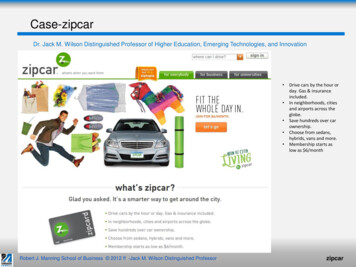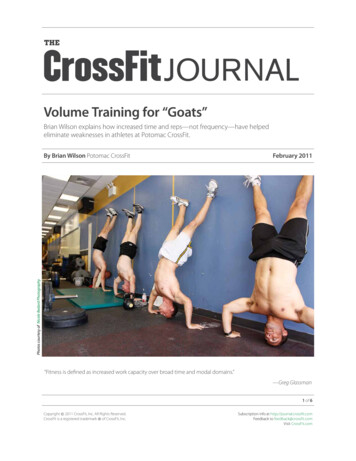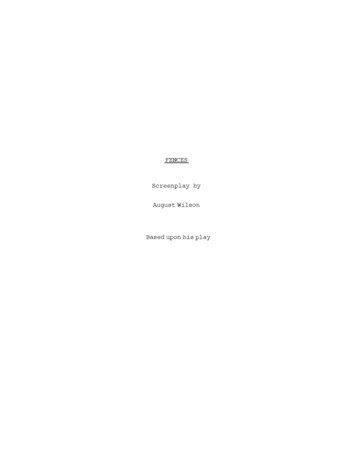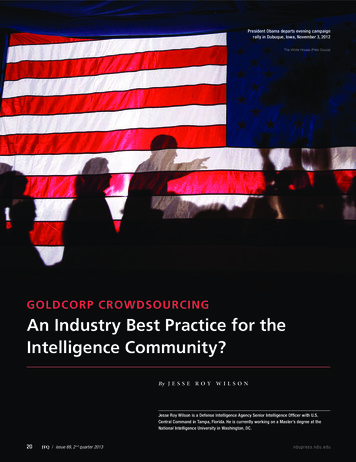
Transcription
Forum Crowdsourcing for the Intelligence CommunityPresident Obama departs evening campaignrally in Dubuque, Iowa, November 3, 2012The White House (Pete Souza)Goldcorp CrowdsourcingAn Industry Best Practice for theIntelligence Community?By J e s s e R o y W i l s o nJesse Roy Wilson is a Defense Intelligence Agency Senior Intelligence Officer with U.S.Central Command in Tampa, Florida. He is currently working on a Master’s degree at theNational Intelligence University in Washington, DC.20 JFQ/ issue 69, 2 n d quarter 2013 ndupres s . ndu. edu
WILSONAgrowing number of businessesuse crowdsourcing—that is,they outsource tasks to peopleoutside the organization1—ina way that harnesses the capabilities andknowledge of external individuals on a massscale to create innovative solutions. Thisarticle describes how Goldcorp, Incorporated, an international gold-mining companyon the brink of collapse, used crowdsourcingvia the Internet to turn its business around.The article then explores some challenges andsuccesses behind crowdsourcing initiativesand offers crowdsourcing as an approachwith applicability for the Intelligence Community (IC).McEwen wondered if he could use the samemodel with the gold mine.Back at Goldcorp, McEwen pitched hisidea to take “all of our geology, all the data wehave that goes back to 1948, and put it intoa file and share it with the world . . . [and]ask the world to tell us where we’re going tofind the next six million ounces of gold.”4 Heexperienced some resistance. For example,the information that McEwen wanted toGoldcorpmake public was proprietary. A miningcompany had never made this informationpublic before.5 Second, the geologists wereconcerned how the message would reflecton their reputations, which essentially toldeveryone—including their competitors—thatthey were unable to find the gold. Nevertheless, McEwen prevailed, and in March 2000he launched the “Goldcorp Challenge,” theworld’s first Internet gold rush.6The idea was simple. The companyposted its entire repository of informationon the 55,000-acre Red Lake property on itsWeb site and offered 575,000 to participantswith the best methods and estimates. Morethan 1,000 participants from 50 countriesregistered for the challenge with submissionscoming from graduate students, consultants,mathematicians, physicists, and militaryofficers. “There were capabilities I had neverseen before in the industry,” stated McEwen.Contestants identified 110 potential sites, halfof which were new to the company, and 80percent of them yielded substantial quantitiesof gold, eventually totaling 8 million ounces.The company estimates that the challengesaved 3 years of exploration time, and in 2001revenues increased 170 percent, cash flowgrew 1,180 percent, and profits soared from 2 million to 52 million.7The company awarded the top four“virtual explorers” a shared prize of 325,000,and 25 semifinalists prizes totaled 250,000.8As Wikinomics ends its story about Goldcorp:In Wikinomics, Don Tapscott, aCanadian business executive and one ofThinkers50’s most influential managementthinkers, works with coauthor Anthony D.Williams to describe how Goldcorp turnedits struggling 1950s gold-mining companyinto a multimillion dollar success.2 Headquartered in Vancouver, British Columbia,Goldcorp employs 14,000 people who operate10 mines in Canada, the United States,Mexico, and Central and South America. Inthe 1990s, the company was struggling withhigh production costs, debt, and strikes. Thenew chief executive officer, Rob McEwen,was new to the gold-mining business, servingpreviously as a young mutual fund managerat Merrill Lynch.3 Goldcorp analysts projected the death of a 50-year-old mine in RedLake, Ontario. Without discovery of new golddeposits, the company seemed likely to godown with it.McEwen held an emergency meetingwith his geologists and made the decisionto send them with 10 million to find goldon the Red Lake property. Weeks later, thegeologists returned with good news. Theyhad discovered gold deposits; however, theywere unable to estimate the value and determine the exact location of the gold. During aMassachusetts Institute of Technology conference in 1999, McEwen listened intently toa presentation on the production of the Linuxcomputer operating system using volunteersoftware developers to “crowdsource” itsdevelopment over the Internet. The company’s chief architect and software engineer,Linus Torvalds, disclosed the company’s software code publically so anonymous developers could review it and make improvements.n d u p res s .ndu.edu and capability. In doing so he stumbled successfully into the future of innovation, business, and how wealth and just about everything else will be created. Welcome to the newworld of wikinomics where collaboration ona mass scale is set to change every institutionin society.9Like Goldcorp, the Intelligence Community could embrace crowdsourcingthe company posted its entire repository ofinformation on its Web site and offered 575,000 toparticipants with the best methodsMcEwen . . . realized the uniquely qualifiedminds to make new discoveries were probablyoutside the boundaries of his organization,and by sharing some intellectual property hecould harness the power of collective geniusto tap into the knowledge and expertiseoutside of its boundaries when appropriate. To explore this possibility, we need tounderstand how crowdsourcing works andits benefits and risks.CrowdsourcingCrowdsourcing is a portmanteau thatrefers to outsourcing tasks from within anorganization to people outside the organization.10 The term originated in 2006 from aWired magazine article in which Jeff Howemodified the term outsourcing to describe abusiness model using the Internet workforcewithout the need for a traditional outsourcing company.11 A variety of other terms areused to describe similar activity, such as openaccess, open innovation, open source, andcollective intelligence. Over the last decade,a number of successful companies haveincorporated this approach. Proctor andGamble uses crowdsourcing to support up to50 percent of its innovations, helping producesuch products as Mr. Clean Magic Eraser andPringles Prints.12 Other examples includeAffinnova, Amazon, Bell Canada’s I.D.ah!,Delicious, Dell’s IdeaStorm, Digg, Goldcorp,Google, IBM, InnoCentive, Kimberly Clark,Kraft, LG Electronics, ManyEyes, Marketocracy, Reckitt Benckiser, Salesforce.com’s IdeaExchange, Swivel, Threadless, and Unilever.13A key difference, however, between crowdsourcing and open innovation in general isthat crowdsourcing typically uses some kindof incentive or reward for the work.14The most well-known crowdsourcingWeb site is Amazon’s Mechanical Turk.15The site gives businesses and developersaccess to 250,000 on-demand workers.Requestors post jobs and workers chooseissue 69, 2 n d quarter 2013 / JFQ 21
U.S. Coast Guard (Ayla Kelley)Forum Crowdsourcing for the Intelligence CommunityAdmiral Thad Allen provides a briefing to the Unified Area Command in New Orleans in response to BP Deepwater Horizon oil spillthe jobs they want for the money offered.One highly cited example was the attemptto use Mechanical Turk to find the crashsite of American entrepreneur and aviatorSteve Fossett, who went missing in his planebetween the Sierra Nevada Mountains andthe Nevada desert. Although the effort didnot find the crash site, an estimated 50,000people looked for Fossett’s plane by reviewing two million snapshots of commercialimagery covering 17,000 square miles.16Wikipedia, the world’s largest encyclopedia,is another example of crowdsourcing. It hasover four million articles (and growing)produced, edited, and reviewed by volunteers. Their reward is simply the satisfactionthat their work is instantly available to theworld. Tara Behrend, an organizationalsciences professor at The George Washington University, states that one unrealizedbenefit of using crowdsourcing over theInternet for research is the potential toreach a wider and more diverse audience tosolve a common research challenge.17There is a growing interest in harnessing crowds to tap the collective intelligenceof the masses, experts and nonexperts alike,to forecast events. Known as predictionmarkets, these initiatives typically posetime-bound questions or statements (forexample, Barack Obama’s 2012 reelection)to users in a market, allowing individuals tobuy and sell contracts based on what theybelieve will happen.18 The idea of dilettantesbeating experts in certain situations hassome merit. Phillip Tetlock, a professor22 JFQ/ issue 69, 2 n d quarter 2013 at the University of California Berkeley,used his seminal Expert Political Judgmentto publish 20 years of research on humanprediction capabilities, using more than20,000 forecasts. His research concludesthat experts have no more forecasting skillthan nonexperts. The best forecasters weremoderate along the ideological spectrum,skeptical of grand schemes, and more likelyto consider contradictory evidence andhypotheses and hedge on their probabilitieswhen making bets.19ChallengesThe director of innovation and policyat the European branch of RAND, JoannaChataway, stated, “We have seen plenty ofanecdotal evidence that crowdsourcing canwork, but there has been little research intohow and where it works best.”20 Indeed, organizations must use caution when launchingcrowdsourcing initiatives to ensure that theydo not harm the image of the company andthat they strike the right balance betweendiversity and expertise, offer the right incentives, and determine up front who has intellectual rights over the information.21For example, the coach of a Finnishsoccer club crowdsourced the recruitmentof players and game tactics to the team’sfans via cell phone voting.22 The seasonended in disaster and the owners fired thecoach. James Euchner, a vice president atGoodyear, argues that many online crowdsourcing initiatives are underdeveloped andunsuccessful.23 For instance, during theDeepwater Horizon oil spill in 2010, publicand private parties launched Web sites andwikis to garner ideas from the public abouthow to stop the oil flowing from the seafloor. Volunteers submitted approximately20,000 suggestions on the United StatesDeepwater Horizon Unified Command Website.24 However, as Euchner points out, mostof the submissions were “notional” andlacked real potential. Moreover, it requiredvast resources to weed through all theinformation.Although there are challenges tocrowdsourcing, there are certain conditionsthat make success more likely. As we sawwith Goldcorp and Mechanical Turk, giventhe right circumstances, companies canaccomplish more by opening their work tothe masses than relying only on companyworkers. In The Wisdom of Crowds, JamesSurowiecki provides four conditions thatenable the aggregate decisions of large groupsto make better judgments than experts: diversityof opinion(avoids groupthink) decentralization (so individuals candraw on local and tacit knowledge) aggregation (using a mechanism toturn individual information into collectivejudgments).25 independenceThe Finnish soccer fans, for example, likelylacked the diversity of opinion and tacitknowledge required to determine recruitment or game tactics.ndupres s . ndu. edu
WILSONLike Goldcorp, the Intelligence Community (IC) deals with sensitive informationand challenging problems. IC assessmentsestablish what is known, unknown, andwhere developments might be heading. TheIC continues to monitor traditional issuessuch as the capabilities and intentions ofnation-states, but it is now responsible forassessing a growing number of nontraditional topics, such as health threats, resourcescarcity, and even global climate change.26Former Deputy Director of National Intelligence (DNI) for Analysis and National Intelligence Council (NIC) Chairman ThomasFingar points to the expanding issues in ICthreat assessments as evidence of the expanding agenda.27 For example, the IC’s 1996Annual Threat Assessment covered China,North Korea, Russia, Iran, a few unstablestates, terrorism, proliferation, narcotics,crime, and economics.28 In 2012, however, thethreat assessment included all of the aboveintelligence topics plus an extended list ofunstable nations, countries in our own hemisphere (Mexico, Cuba, and Haiti), the ArabSpring, tense relationships between countriesin various regions, space, water security,health threats, and natural disasters.29Two trends make crowdsourcing viathe Internet an attractive option for the IC.First, as exemplified by NIC assessments onglobal trends,30 many of the new intelligencetopics (and their sources, methods, andjudgments) are unclassified and less sensitivethan traditional political and military relatedtopics. Thus, classification restrictions areminimal. Second, the required knowledgeand expertise on these issues are not typicallyavailable through the traditional intelligencedisciplines (human, signals, and geospatial)and exist outside the IC in academia, nongovernmental organizations, and business.In 2007, the DNI published a directiveon analytic outreach, defined as the “open,overt, and deliberate act of an IC analystengaging with an individual outside the ICto explore ideas and alternative perspectives,gain new insights, generate new knowledge,or obtain new information.”31 Acknowledging the need for the IC to expand its knowledge base and share burdens, the new policydirects analysts to tap outside expertise, ICelements to establish an analytic outreachcoordinator, and the IC to use outside expertswhenever possible. The preparation of then d u p res s .ndu.edu 2008 NIC report Global Trends 2025 includedAmerican and non-American contributionsthrough conferences, commissioned studies,and for the first time through a special Website to allow comments on drafts.32Embracing expertise wherever it residesis an increasing requirement. Just in thelast year, the Defense Advanced ResearchProjects Agency launched a crowdsourci
Kraft, LG Electronics, ManyEyes, Marketoc - racy, Reckitt Benckiser, Salesforce.com’s Idea . Wikipedia, the world’s largest encyclopedia, is another example of crowdsourcing. It has over four million articles (and growing) produced, edited, and reviewed by volun-teers. Their reward is simply the satisfaction that their work is instantly available to the world. Tara Behrend, an .
